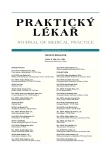ECG changes during endoscopic procedures in upper gastrointestinal tract
Authors:
M. Makovník 1; Ľ. Gašpar 1; S. Hlinšťáková 1; Ľ. Lukáč 2; J. Lietava 1; A. Dukát 1
Authors‘ workplace:
II. interná klinika Lekárskej fakulty UK a UN Bratislava, Slovenská republika
Prednosta: doc. MUDr. Ľudovít Gašpar, CSc.
1; I. interná klinika Lekárskej fakulty UK a UN Bratislava, Slovenská republika
Prednosta: doc. MUDr. Soňa Kiňová, PhD.
2
Published in:
Prakt. Lék. 2012; 92(3): 145-149
Category:
Of different specialties
Overview
Aim of the study:
To compare Holter electrocardiography (ECG) record in patients during endoscopic procedure with the period in which patients carry out their usual activities and to evaluate the cardiovascular response to endoscopic procedure.
Methods:
Ambulatory 24-hour ECG monitoring by Holter was used to detect ischemia and dysrhythmias. The actual endoscopic procedure (gastroduodenoscopy or endoscopic retrograde cholangiopancreatography ERCP) was performed during this period.
Patients:
We investigated a group of 116 persons, which, with its characteristics, constitutes a representative selection of patients undergoing elective upper gastrointestinal endoscopy procedures in the endoscopic department of a general hospital in Bratislava.
Results:
We found a high prevalence of ischemia (17.2 %) and complex forms of cardiac dysrhythmia - Lown III-V (12.9 %) during the endoscopic procedure.
Significant myocardial ischemia, which didn’t occur during the rest of the monitoring period, was recorded during the endoscopic procedure in 7.8 % of patients.
Higher class of complex forms of ventricular ectopic beats (by Lown’s classification) during the endoscopic procedure was recorded in 7.4% of patients when compared to the rest of the period, a lower class was recorded in 20.7% of patients.
Conclusions:
Based on the results, we found that anti-ischaemic and anti-dysrhythmic therapies are protective factors for ischemia and dysrhythmia during upper gastrointestinal endoscopy. It is therefore important that the patient does not miss these therapies in preparation for the endoscopic procedure.
Key words:
gastroscopy, Holter ECG monitoring, arrhythmias, ischaemia.
Sources
1. Alberti, K. Zimmet, P., Shaw, J. Metabolic syndrome—a new world-wide definition. A Consensus Statement from the International Diabetes Federation. Diabetic. medicine 2006, 23, p. 469-480.
2. Berisso, M., Carratino, L., Ferroni, A. et al. Frequency, characteristics and significance of supraventricular tachyarrhythmias detected by 24-hour electrocardiographic recording in the late hospital phase of acute myocardial infarction. Am. J. Cardiol. 1990, 65, p. 1064-1070.
3. Camm, A., Kirchhof, P., Lip, G. et al. Guidelines for the Management of Atrial Fibrillation. Eur. Heart. J. 2010, 31, p. 2369-2429.
4. Cohen, L. Patient monitoring during gastrointestinal endoscopy: why, when, and how? Gastrointest. Endosc. Clin. N. Am. 2008, 18, p. 651-663.
5. Dukát, A. Ambulantné monitorovanie EKG pri sledovaní zmien ST segmentu. Neinvazívna Kardiológia 1992, 2, s. 45-48.
6. Filip, K., Vondráček, L. Reforma zdravotníctví a vztahy mezi zdravotníky a pacienty. Prakt. Lék. 2008, 88, 3, s. 127-129.
7. Gašpar, Ľ, Poliak, P, Makovník, M. a kol. Obezita a artériová hypertenzia. Vnitř. Lék. 2010, 56, s. 1074-1077.
8. Gavorník, P. Všeobecná angiológia. Angiologická propedeutika. Cievne choroby. 2. rozšírené a doplnené vyd. Bratislava: Univerzita Komenského-vydavateľstvo UK. 2001 : 268 s. ISBN 80-223-1608-3.
9. Gavorník, P. Končatinovocievne ischemické choroby. B 2.1 : 1-92. In: Gavorník P, Hrubiško M, Roborilová E (eds). Diferenciálna diagnostika kardio-vaskulárnych, respiračných a hematologických ochorení. I. 1. vyd. Bratislava: Dr. Josef Raabe, 2010 : 300 s. ISBN 978-80-89182-46-6.
10. Lown, B., Wolf, M. Approaches to sudden death from coronary heart disease. Circulation 1971, 44, p. 130-142.
11. McAlpine, J., Martin, B., Devine, B. Cardiac arrhythmias associated with upper gastrointestinal endoscopy in elderly subjects. Scott. Med. J. 1990, 35, p. 102-104.
12. Özdog̃an, M., Gür, G., Özgür, O. et al. Cardiac implications of esophagogastroduodenoscopy in patient with coronary disease. Turk. J. Gastroenterol. 2000; 11, p. 136-140.
13. Schenck, J., Muller, Ch., Lubbers, H. et al. Does gastroscopy induce myocardial ischemia in patients with coronary heart disease? Endoscopy 2000, 32, p. 373-376.
14. Ulgen, S., Ateș, Y., Soypaçaci, Z., Keleș, T. Effects of upper gastrointestinal endoscopy on the cardiovascular system of asymptomatic middle-aged and eldery patients without heart disease. Turk. J. Gastroenterol. 2001, 12, p. 214-211.
15. Wilcox, M., Faibicher, M., Wenger, N. et al. Prevalence of silent myocardial ischemia and arrhythmias in patients with coronary heart disease undergoing gastrointestinal tract endoscopic procedures. Arch. Intern. Med. 1993, 153, p. 2325-2332.
16. Yazawa, K., Adachi, W., Koide, N. et al. Changes in cardiopulmonary parameters during upper gastrointestinal endoscopy in patients with heart disease: towards safe endoscopy. Endoscopy 2000, 32, p. 287-293.
Labels
General practitioner for children and adolescents General practitioner for adultsArticle was published in
General Practitioner

2012 Issue 3
Most read in this issue
- Testicular microlithiasis
- Nursing interventions in home care
- The influence of ageing on cognitive functions and their evaluation in general practice
- General practitioner and rehabilitation
